Abstract
1-Butyryl-glycerol (monobutyrin) is a simple lipid product of adipocytes with angiogenic activity. Recent studies have shown that the biosynthesis of this compound is tightly linked to lipolysis, a process associated with changes in blood flow. We now present data indicating that monobutyrin is an effective vasodilator of rodent blood vessels using a fluorescent retinal angiogram assay. The vasodilatory activity of monobutyrin is potent (ED50 = 3.3 x 10(-7) M), dose dependent, and stereospecific. Because diabetes represents a catabolic, lipolytic state with numerous vascular complications, we examined the action and regulation of monobutyrin in insulin-deficient diabetic rats. Serum levels of monobutyrin in streptozotocin-induced diabetic rats were greatly elevated compared to normal animals. At the same time, the retinal vessels of the diabetic animals develop a resistance to the vasodilatory activity of monobutyrin. These results demonstrate a role for monobutyrin in the control of vascular tone and suggest a possible involvement in the pathology of diabetes.
Full text
PDF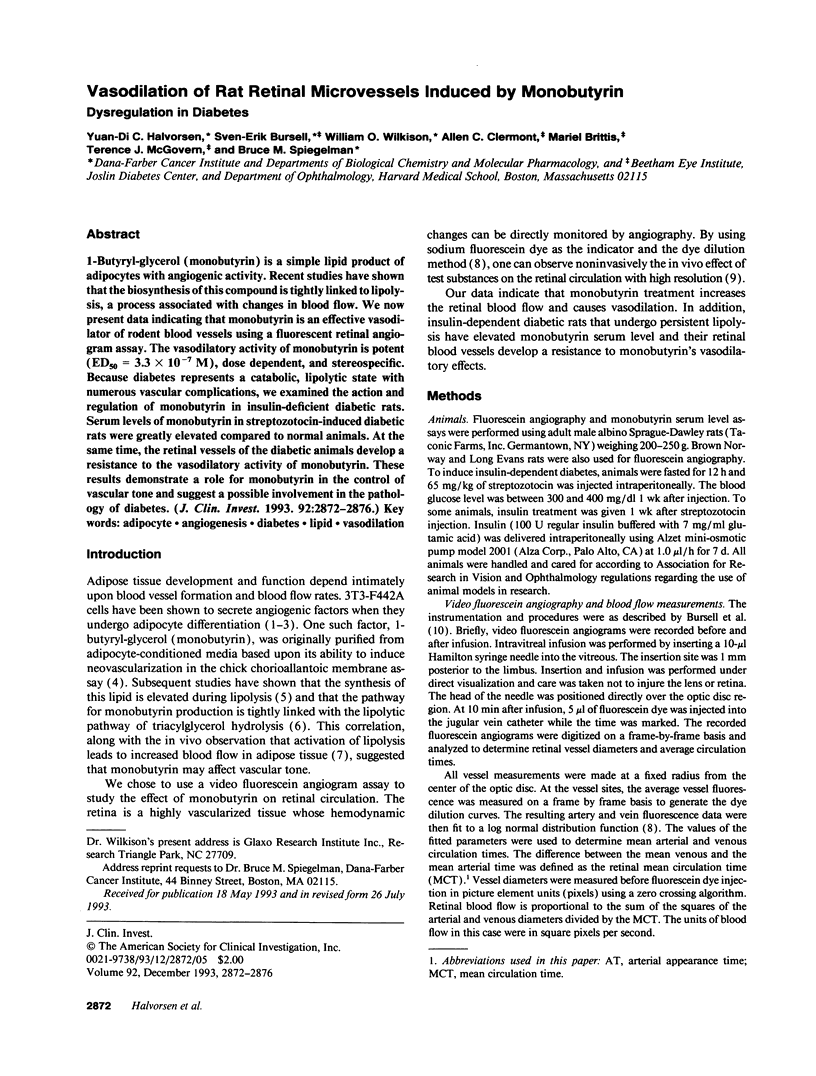
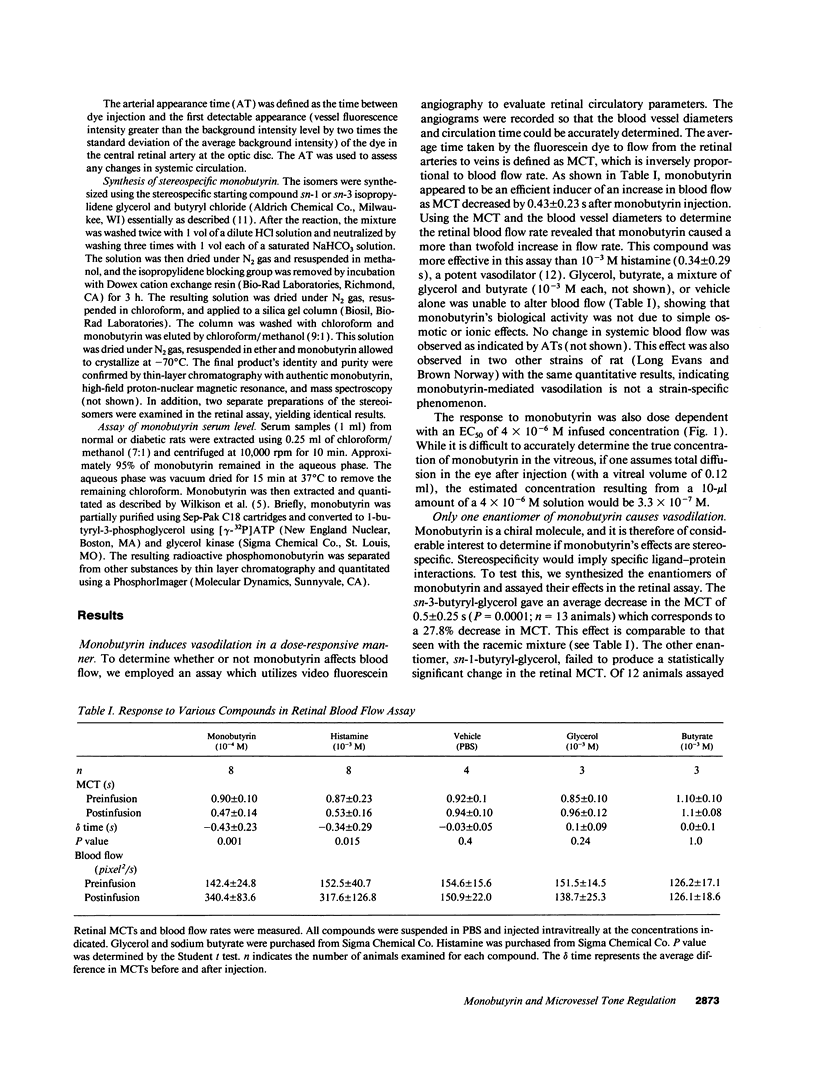
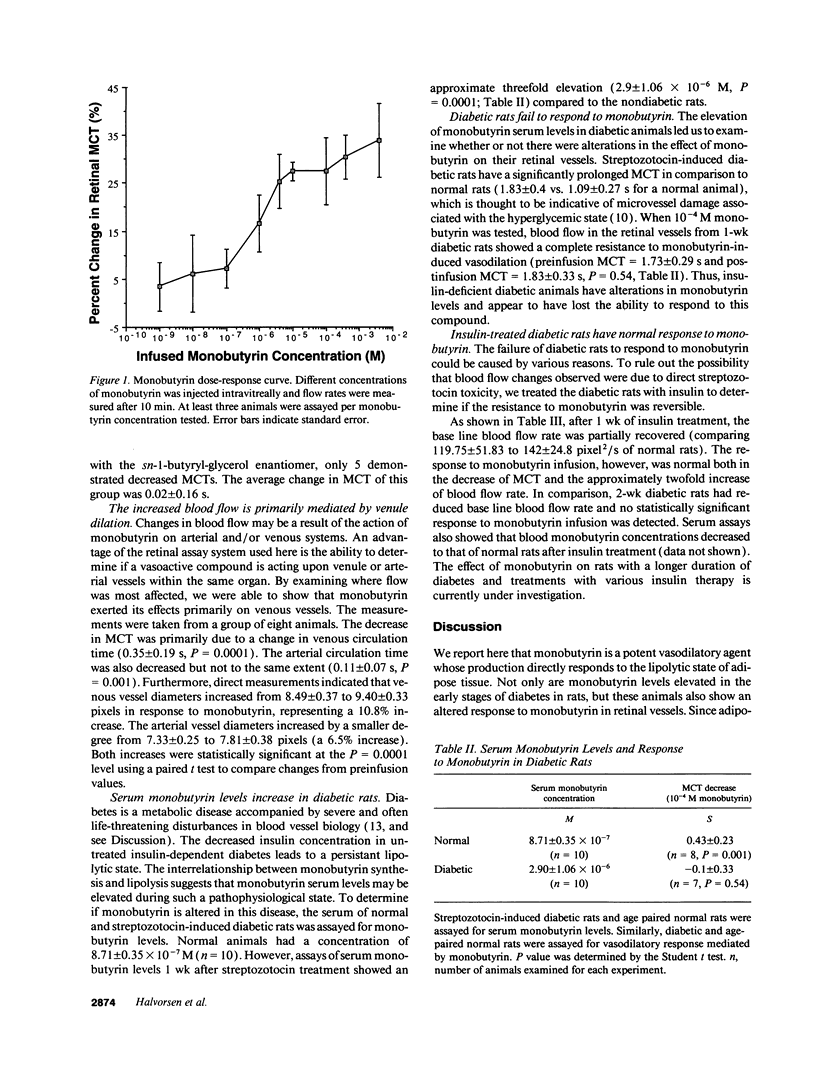
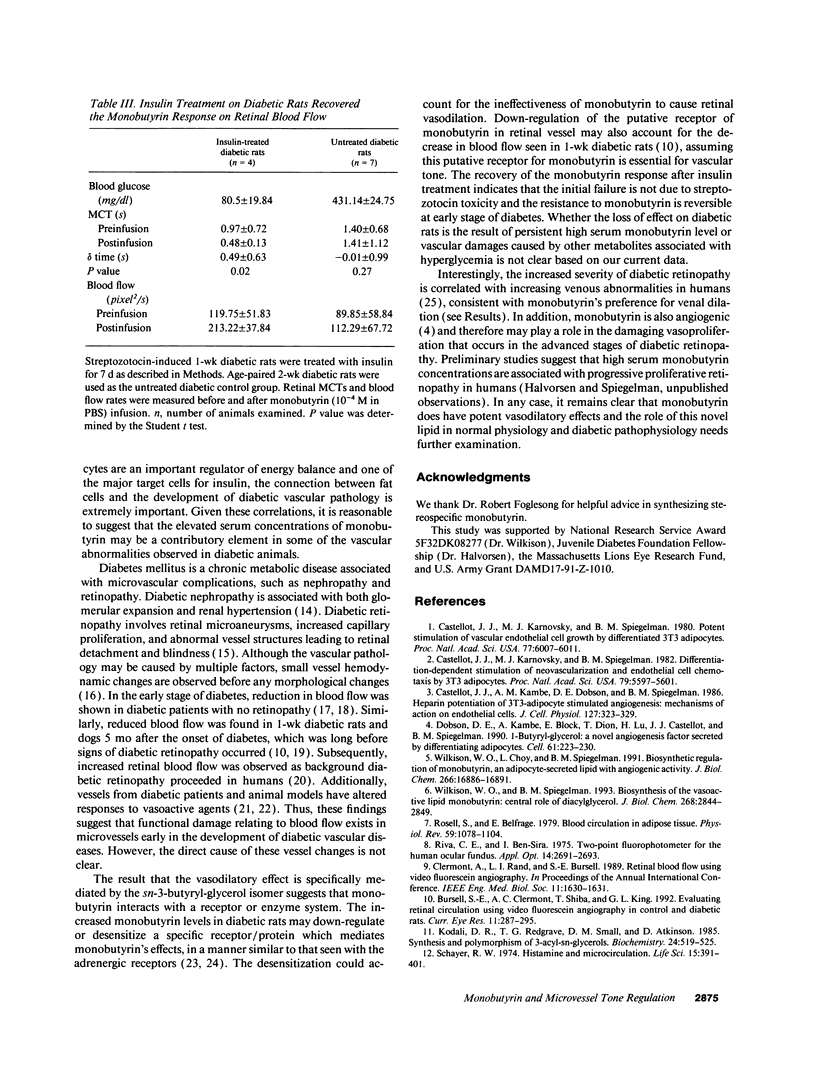
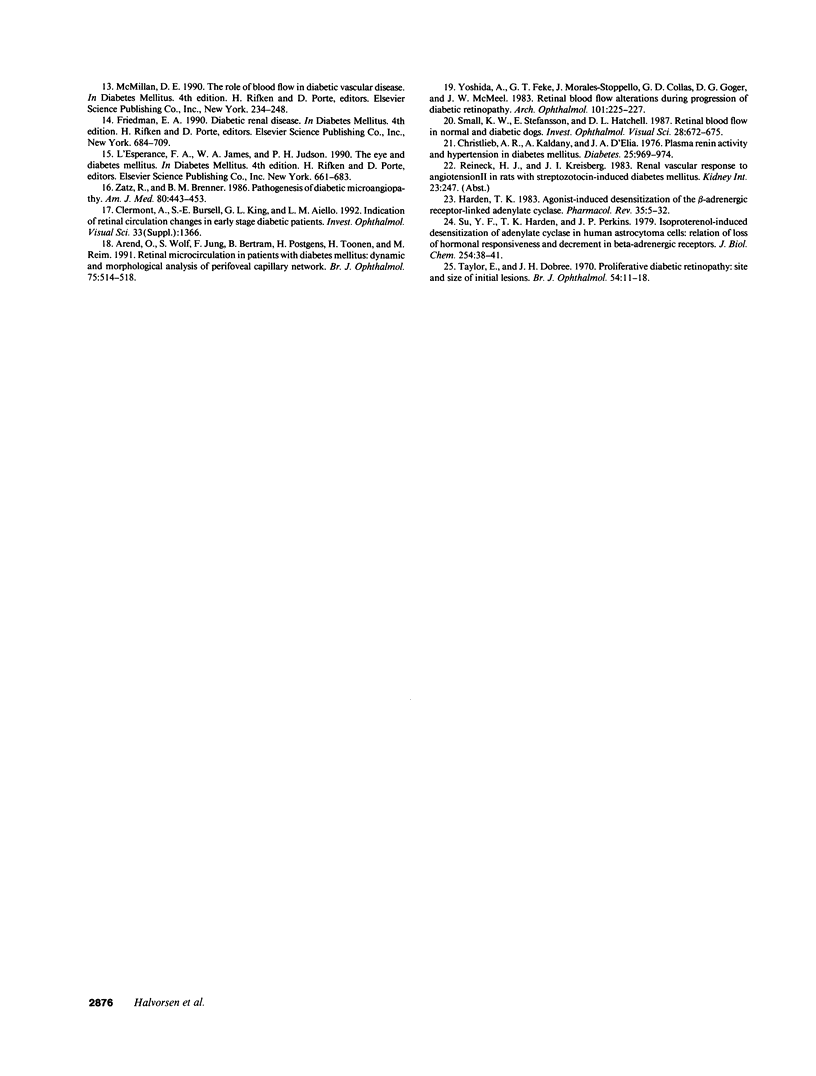
Selected References
These references are in PubMed. This may not be the complete list of references from this article.
- Arend O., Wolf S., Jung F., Bertram B., Pöstgens H., Toonen H., Reim M. Retinal microcirculation in patients with diabetes mellitus: dynamic and morphological analysis of perifoveal capillary network. Br J Ophthalmol. 1991 Sep;75(9):514–518. doi: 10.1136/bjo.75.9.514. [DOI] [PMC free article] [PubMed] [Google Scholar]
- Bursell S. E., Clermont A. C., Shiba T., King G. L. Evaluating retinal circulation using video fluorescein angiography in control and diabetic rats. Curr Eye Res. 1992 Apr;11(4):287–295. doi: 10.3109/02713689209001782. [DOI] [PubMed] [Google Scholar]
- Castellot J. J., Jr, Kambe A. M., Dobson D. E., Spiegelman B. M. Heparin potentiation of 3T3-adipocyte stimulated angiogenesis: mechanisms of action on endothelial cells. J Cell Physiol. 1986 May;127(2):323–329. doi: 10.1002/jcp.1041270221. [DOI] [PubMed] [Google Scholar]
- Castellot J. J., Jr, Karnovsky M. J., Spiegelman B. M. Differentiation-dependent stimulation of neovascularization and endothelial cell chemotaxis by 3T3 adipocytes. Proc Natl Acad Sci U S A. 1982 Sep;79(18):5597–5601. doi: 10.1073/pnas.79.18.5597. [DOI] [PMC free article] [PubMed] [Google Scholar]
- Castellot J. J., Jr, Karnovsky M. J., Spiegelman B. M. Potent stimulation of vascular endothelial cell growth by differentiated 3T3 adipocytes. Proc Natl Acad Sci U S A. 1980 Oct;77(10):6007–6011. doi: 10.1073/pnas.77.10.6007. [DOI] [PMC free article] [PubMed] [Google Scholar]
- Christlieb A. R., Kaldany A., D'Elia J. A. Plasma renin activity and hypertension in diabetes mellitus. Diabetes. 1976 Oct;25(10):969–974. doi: 10.2337/diab.25.10.969. [DOI] [PubMed] [Google Scholar]
- Dobson D. E., Kambe A., Block E., Dion T., Lu H., Castellot J. J., Jr, Spiegelman B. M. 1-Butyryl-glycerol: a novel angiogenesis factor secreted by differentiating adipocytes. Cell. 1990 Apr 20;61(2):223–230. doi: 10.1016/0092-8674(90)90803-m. [DOI] [PubMed] [Google Scholar]
- Harden T. K. Agonist-induced desensitization of the beta-adrenergic receptor-linked adenylate cyclase. Pharmacol Rev. 1983 Mar;35(1):5–32. [PubMed] [Google Scholar]
- Kodali D. R., Redgrave T. G., Small D. M., Atkinson D. Synthesis and polymorphism of 3-acyl-sn-glycerols. Biochemistry. 1985 Jan 15;24(2):519–525. doi: 10.1021/bi00323a041. [DOI] [PubMed] [Google Scholar]
- Rosell S., Belfrage E. Blood circulation in adipose tissue. Physiol Rev. 1979 Oct;59(4):1078–1104. doi: 10.1152/physrev.1979.59.4.1078. [DOI] [PubMed] [Google Scholar]
- Schayer R. W. Histamine and microcirculation. Life Sci. 1974 Aug 1;15(3):391–401. doi: 10.1016/0024-3205(74)90338-5. [DOI] [PubMed] [Google Scholar]
- Small K. W., Stefánsson E., Hatchell D. L. Retinal blood flow in normal and diabetic dogs. Invest Ophthalmol Vis Sci. 1987 Apr;28(4):672–675. [PubMed] [Google Scholar]
- Su Y. F., Harden T. K., Perkins J. P. Isoproterenol-induced desensitization of adenylate cyclase in human astrocytoma cells. Relation of loss of hormonal responsiveness and decrement in beta-adrenergic receptors. J Biol Chem. 1979 Jan 10;254(1):38–41. [PubMed] [Google Scholar]
- Taylor E., Dobree J. H. Proliferative diabetic retinopathy. Site and size of initial lesions. Br J Ophthalmol. 1970 Jan;54(1):11–18. doi: 10.1136/bjo.54.1.11. [DOI] [PMC free article] [PubMed] [Google Scholar]
- Wilkison W. O., Choy L., Spiegelman B. M. Biosynthetic regulation of monobutyrin, an adipocyte-secreted lipid with angiogenic activity. J Biol Chem. 1991 Sep 5;266(25):16886–16891. [PubMed] [Google Scholar]
- Wilkison W. O., Spiegelman B. M. Biosynthesis of the vasoactive lipid monobutyrin. Central role of diacylglycerol. J Biol Chem. 1993 Feb 5;268(4):2844–2849. [PubMed] [Google Scholar]
- Yoshida A., Feke G. T., Morales-Stoppello J., Collas G. D., Goger D. G., McMeel J. W. Retinal blood flow alterations during progression of diabetic retinopathy. Arch Ophthalmol. 1983 Feb;101(2):225–227. doi: 10.1001/archopht.1983.01040010227008. [DOI] [PubMed] [Google Scholar]
- Zatz R., Brenner B. M. Pathogenesis of diabetic microangiopathy. The hemodynamic view. Am J Med. 1986 Mar;80(3):443–453. doi: 10.1016/0002-9343(86)90719-9. [DOI] [PubMed] [Google Scholar]


